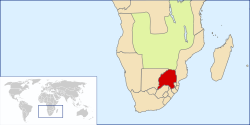
Back Transvaalkolonie Afrikaans Colonia de Transvaal AST ترانسوال کولونیسی AZB Colònia del Transvaal Catalan Colonia de Transvaal Spanish Transvaali koloonia Estonian Transvaal kolonia Basque Transvaalin siirtomaa Finnish Transvaal (colonie) French ट्रांस्वाल उपनिवेश Hindi
Transvaal Colony Transvaalkolonie | |||||||||||
|---|---|---|---|---|---|---|---|---|---|---|---|
| |||||||||||
 Location of Transvaal, circa 1890 | |||||||||||
| Status | Crown colony of the United Kingdom | ||||||||||
| Capital | Pretoria | ||||||||||
| Official language | English | ||||||||||
Common languages | Afrikaans, Dutch, Ndebele, Sepedi, Tsonga, Tswana, Venda, Zulu | ||||||||||
| Ethnic groups (1904) | |||||||||||
| Religion | |||||||||||
| Government | Constitutional monarchy | ||||||||||
| Monarch | |||||||||||
• 1902–1910 | Edward VII | ||||||||||
• 1910 | George V | ||||||||||
| Governor | |||||||||||
• 1902–1905 | Viscount Milner | ||||||||||
• 1905–1910 | Earl of Selborne | ||||||||||
| Prime Minister | |||||||||||
• 1907–1910 | Louis Botha | ||||||||||
| Legislature | Parliament of the Transvaal | ||||||||||
| Legislative Council | |||||||||||
| Legislative Assembly | |||||||||||
| Historical era | Scramble for Africa | ||||||||||
• Established | 12 April 1877 | ||||||||||
| 3 August 1881 | |||||||||||
• 'Transvaal Colony' Proclaimed | 1 September 1900 | ||||||||||
| 31 May 1902 | |||||||||||
• Grant of responsible self-government | 6 December 1906 | ||||||||||
| 31 May 1910 | |||||||||||
| Population | |||||||||||
• 1904 | 1,268,716[1] | ||||||||||
| |||||||||||
| Today part of | South Africa Eswatini | ||||||||||
The Transvaal Colony (Afrikaans pronunciation: [ˈtransfɑːl]) was the name used to refer to the Transvaal region during the period of direct British rule and military occupation between the end of the Second Boer War in 1902 when the South African Republic was dissolved, and the establishment of the Union of South Africa in 1910. The borders of the Transvaal Colony[2] were larger than the defeated South African Republic (which had existed from 1856 to 1902).[3] In 1910 the entire territory became the Transvaal Province of the Union of South Africa.
- ^ Cite error: The named reference
britcensuswas invoked but never defined (see the help page). - ^ De Villiers, John (1896). The Transvaal. London: Chatto & Windus.
- ^ Irish University Press Series: British Parliamentary Papers Colonies Africa, BPPCA Transvaal Vol 37 (1971) No 41 at 267
© MMXXIII Rich X Search. We shall prevail. All rights reserved. Rich X Search

